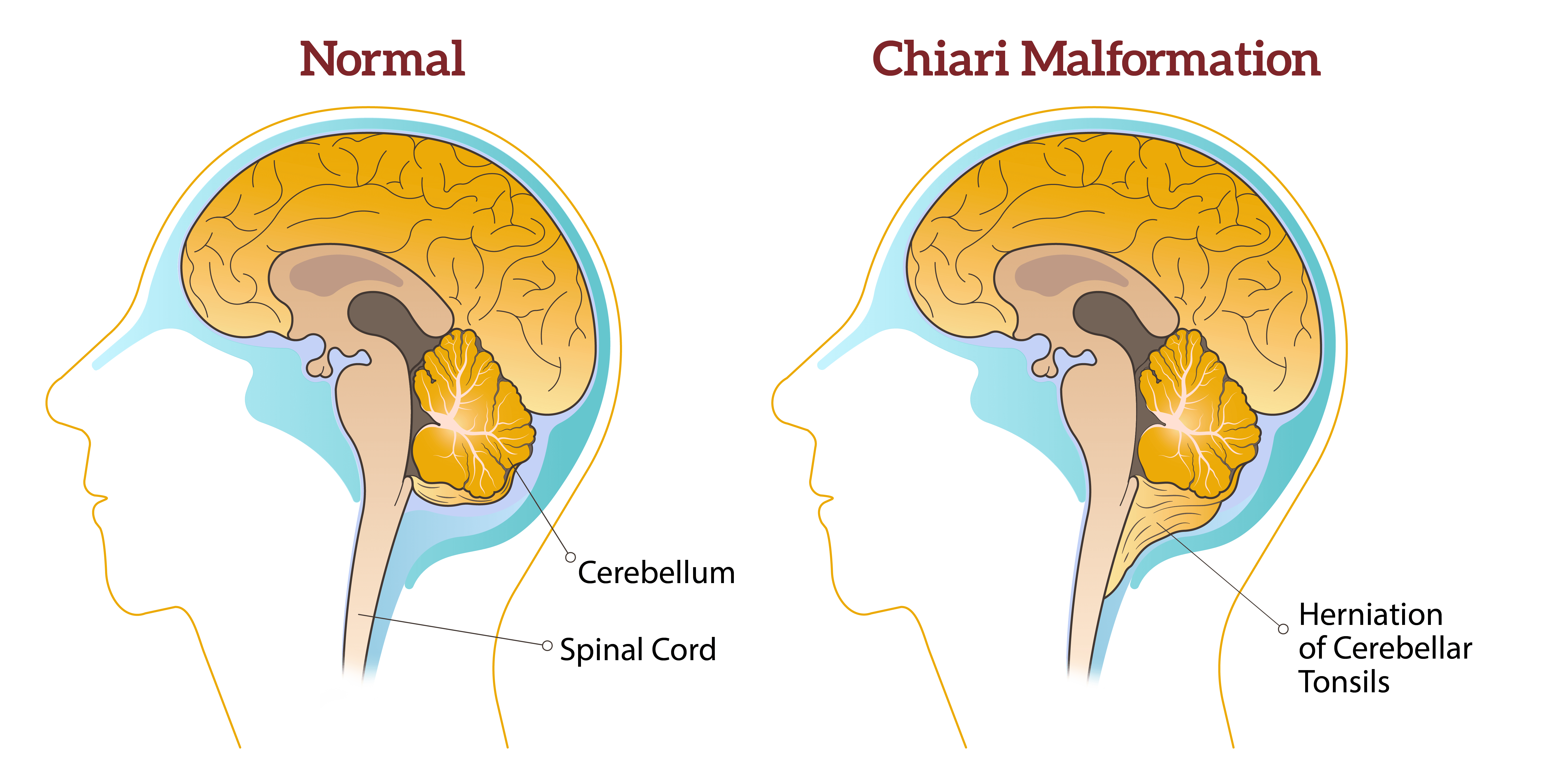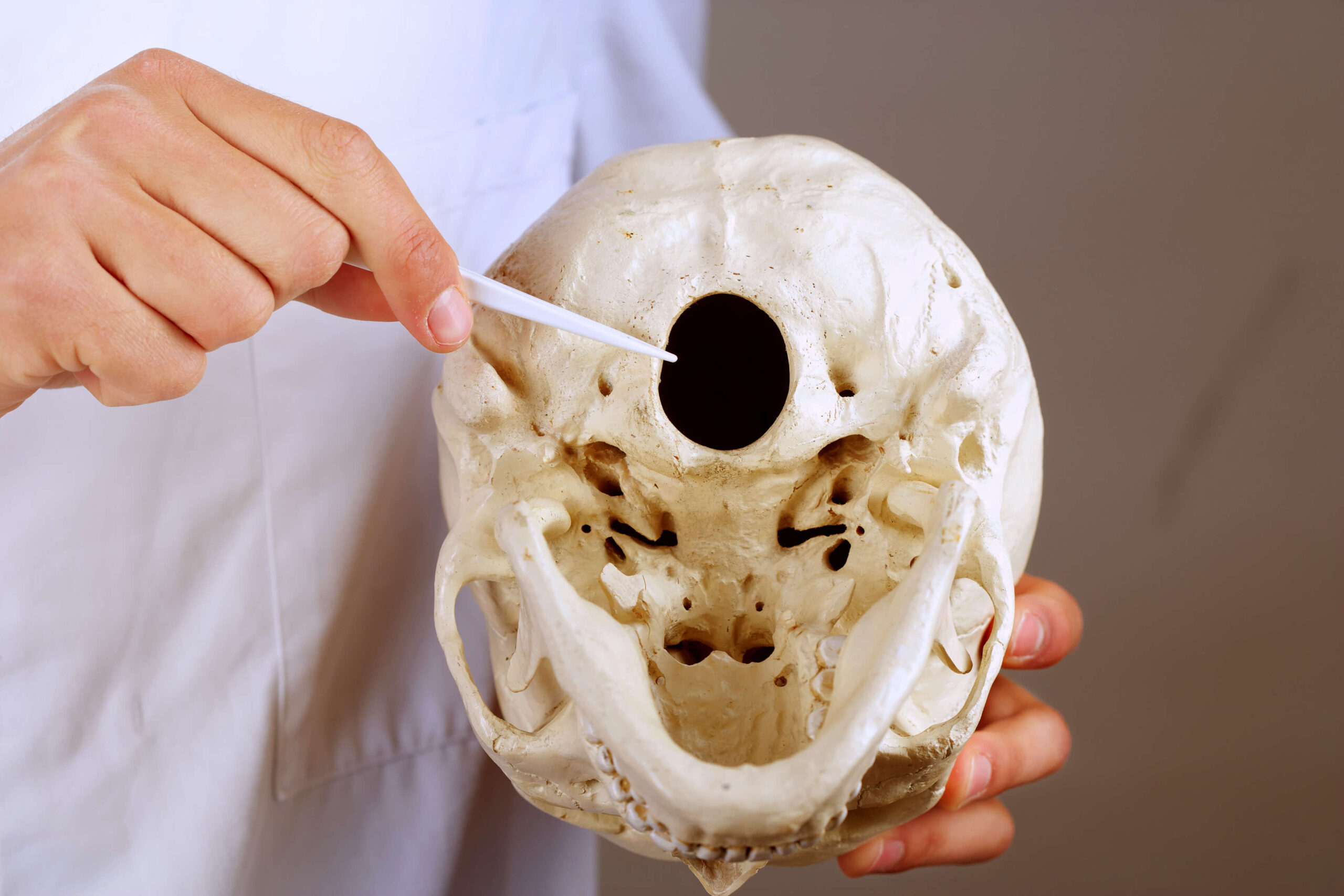Chiari malformations occur when the part of the brain at the base of the skull pushes into the spinal canal. Type I Chiari Malformation is the most common type, diagnosed when the lower part of the cerebellum, the tonsils, push down through an opening between the skull and the spinal cord, restricting the natural flow of fluid and sometimes creating a fluid-filled cyst called a syrinx.

Causes
Chiari malformations can occur either during fetal development (called primary or congenital) or later in life due to injury or illness (called secondary or acquired). Primary Chiari malformations are significantly more common than secondary Chiari malformations.
Treatment Options
Physicians can diagnose Type I Chiari Malformation using an MRI, which shows the soft tissue of the brain and spine. The objective is to determine whether there is an obstruction in the flow of cerebrospinal fluid, which may affect functionality. A CT scan, or other imaging tests, may also be ordered before determining a treatment plan.
Non-Surgical
If there are no symptoms, treatment may not be necessary at all. However, if symptoms are mild, your doctor may recommend one of the following:
- Over-the-Counter Medication: Over-the-counter medications may include NSAIDs (Non-Steroidal Anti-Inflammatory Drugs) such as ibuprofen (Advil) and naproxen (Aleve) or Analgesics such as acetaminophen (Tylenol) to manage or alleviate headache or neck pain.
- Physical Therapy: Certain exercises may help manage pain, stiffness, or weakness.
- Neck Collars: Soft neck braces and collars can help support the neck and provide some pain relief.
Surgical
If symptoms are severe, your doctor may recommend decompression surgery to prevent further damage to the central nervous system and provide symptom stabilization or relief.
The most common surgical treatment method for Type I Chiari Malformation is suboccipital craniectomy, in which the surgeon removes a small piece of the skull to create space and relieve pressure. This may be done with or without a C1 (first vertebra) laminectomy and duraplasty, in which the surgeon removes a portion of the bone and creates a patch to enlarge the dura (membrane) around the brain.

The largest opening at the base of the skull is the foramen magnum, through which the spinal cord enters and connects to the brainstem.
Which Treatment Is Right for Me?
Because many of these symptoms are common in other conditions, Type I Chiari Malformation is often misdiagnosed. At Nkrumah Neurosurgery, Dr. Nkrumah is very familiar with the condition and confident he can reach an accurate diagnosis for your situation.
During your appointment, Dr. Nkrumah will spend at least an hour with you, learning about your symptoms, discussing various treatment options, answering your questions, and providing recommendations. Together, you will develop a treatment plan based on your symptoms, lifestyle, and preferences, and you will have options every step of the way to make your road to recovery as comfortable as possible.
For any questions or to schedule an appointment, contact our office by calling (631) 525-1420 or sending us a message.
Sources:
https://www.ncbi.nlm.nih.gov/books/NBK554609/
https://www.ninds.nih.gov/health-information/disorders/chiari-malformations
Symptoms
Many patients with Type I Chiari Malformation do not experience any symptoms. However, even if symptoms do not develop initially, they may develop over time or with the development of a syrinx.
Common symptoms of Type I Chiari Malformation include:
- Headache and/or neck pain, which may worsen with coughing, sneezing, or straining. Headache may be positional, for example, present only when standing or lying down
- Dizziness, often upon standing
- Nausea or vomiting
- Ringing in the ears, also known as tinnitus
- Unsteady gait or difficulty balancing
- Muscle weakness and/or stiffness in the arms, legs, shoulders, or back
- Numbness and/or paresthesia in the hands or feet
- Difficulty swallowing
- Loss of hand coordination and fine motor skills
- Scoliosis
- Sudden black-out episodes, which may be triggered by a sudden change in position, sneezing or coughing
What is the cerebellum?
The cerebellum is a major structure of the hindbrain that is located near the brainstem. It helps to coordinate voluntary movements including motor skills such as balance, coordination, and posture.
Normally the cerebellum fits inside the base of the skull, or posterior fossa. Two small protrusions called the tonsils extend under surface of the cerebellum. A space filled with cerebrospinal fluid (CSF) is found in front of the cerebellum, behind the brainstem. These structures are located just above the foramen magnum, the largest opening at the base of the skull through which the spinal cord enters and connects to the brainstem. Symptoms may arise when these structures bulge through the foramen magnum.
The tonsils themselves are thought to be vestigial, meaning they have no known function at this point in human evolution. In a healthy adult, the cerebellar tonsils should not extend more than 3 mm below the foramen magnum. Between 3 and 5 mm is considered borderline. Chiari malformations larger than 5 mm are often symptomatic and may require treatment.
What are the four types of Chiari malformations?
Type I: In this most common form, the cerebellar tonsils descend through the bottom of the skull and into the spinal canal. This may be congenital—developing before birth, or acquired—due to an injury or other event. Cerebellar Tonsils normally shrink as a child grows, but if they don’t, symptoms may occur.
Type II: Also known as Arnold-Chiari malformation, this more severe condition involves the extension of both the cerebellar and brain stem tissue through the base of the skull. It is usually accompanied by a myelomeningocele (a form of spina bifida).
Type III: In this most serious form, an encephalocele, or protrusion of brain tissue through the skull, is present. This is often accompanied by severe neurological defects.
Type IV: In rare cases when the cerebellum fails to develop normally, or part of the brain is missing, the most severe form of Chiari Malformation may occur.






